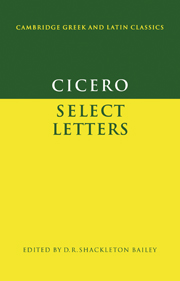Commentary
Published online by Cambridge University Press: 05 June 2012
Summary
LETTER I (Att. 1.5)
This is the earliest of Cicero's extant letters. Atticus had returned to Greece from one of his periodical visits to Italy and was now on his recently bought estate near Buthrotum in Epirus, opposite the island of Corcyra (Corfù). On the letter-headings in the Atticus correspondence see Introd. p. 11.
1 Luci Cicero's cousin L. Cicero had been with him at Athens in 79 and assisted him in the Verres case. The children of brothers (fratres patrueles) can be termed simply fratres (sorores).
humanitate A key word in Cicero's vocabulary. It connotes thoughtfulness for other people (kindness, tact, courtesy) and also culture – hence the ‘humanities’. For to the Roman way of thinking, or at any rate to Cicero's, the first was a natural product of the second, mores (‘ways’) may be good or bad according to the context.
adfinem Loosely = ‘connexion by marriage’. L. Cicero's cousin Quintus had married Atticus' sister. In a legal sense neither Lucius nor Marcus Cicero was Atticus' adfinis.
2 quod…scribis Lit. ‘as to the fact that you write…’ (cf. Letter 10.1 n.). Translate simply: ‘you write …’.
sorore Exactly when the marriage between Q. Cicero and Pomponia took place is uncertain. Quintus was away from Rome when Cicero wrote, but expected back any day (sec. 8).
quantae…curae In English a nominative would be used: ‘how great an anxiety it has been to me’, i.e. ‘how anxious I have been’.
3 […]
- Type
- Chapter
- Information
- Cicero: Select Letters , pp. 113 - 220Publisher: Cambridge University PressPrint publication year: 1980



